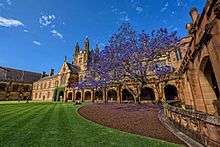Jacaranda mimosifolia
Jacaranda mimosifolia is a sub-tropical tree native to south-central South America that has been widely planted elsewhere because of its attractive and long-lasting pale indigo flowers. It is also known as the jacaranda, blue jacaranda, black poui, or fern tree. Older sources call it J. acutifolia, but it is nowadays more usually classified as J. mimosifolia. In scientific usage, the name "jacaranda" refers to the genus Jacaranda, which has many other members, but in horticultural and everyday usage, it nearly always means the blue jacaranda.
| Jacaranda mimosifolia | |
|---|---|
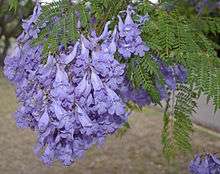 | |
| Scientific classification | |
| Kingdom: | Plantae |
| Clade: | Tracheophytes |
| Clade: | Angiosperms |
| Clade: | Eudicots |
| Clade: | Asterids |
| Order: | Lamiales |
| Family: | Bignoniaceae |
| Genus: | Jacaranda |
| Species: | J. mimosifolia |
| Binomial name | |
| Jacaranda mimosifolia | |
| Synonyms[2] | |
| |
In its native range in the wild, J. mimosifolia is listed as Vulnerable by the IUCN.[3]
Ornamental use
The blue jacaranda has been cultivated in almost every part of the world where there is no risk of frost; established trees, however, tolerate brief spells of temperatures down to around −7 °C (19 °F).[4] In the US, 48 km (30 mi) east of Los Angeles, where winter temperatures can dip to −12 °C (10 °F) for several-hour periods, the mature tree survives with little or no visible damage. Even when young trees are damaged by a hard frost and suffer die back, they will often rebound from the roots and grow in a shrub-like, multi-stemmed form.[4] However, flowering and growth will be stunted if the jacaranda is grown directly on the California coast, where a lack of heat combined with cool ocean winds discourages flowering.[4]
The jacaranda is regarded as an invasive species in parts of South Africa and Australia, the latter of which has seen the blue jacaranda preventing growth of native species.
Description
The tree grows to a height of up to 20 m (66 ft).[5] Its bark is thin and grey-brown, smooth when the tree is young but eventually becoming finely scaly. The twigs are slender and slightly zigzag; they are a light reddish-brown. The flowers are up to 5 cm (2.0 in) long, and are grouped in 30 cm (12 in) panicles. They appear in spring and early summer, and last for up to two months. They are followed by woody seed pods, about 5 cm (2.0 in) in diameter, which contain numerous flat, winged seeds. The blue jacaranda is cultivated even in areas where it rarely blooms, for the sake of its large compound leaves. These are up to 45 cm (18 in) long and bi-pinnately compound, with leaflets little more than 1 cm (0.39 in) long. There is a white form available from nurseries.
The unusually shaped, tough pods, which are 5.1 to 7.6 cm (2 to 3 in) across, are often gathered, cleaned and used to decorate Christmas trees and dried arrangements.
_3.jpeg) J. mimosifolia fruits
J. mimosifolia fruits A jacaranda seed pod
A jacaranda seed pod.jpg) Early jacaranda sprout
Early jacaranda sprout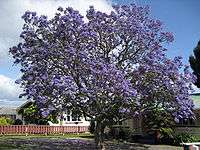 Tree in flower
Tree in flower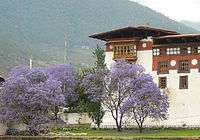 Jacaranda trees in Bhutan
Jacaranda trees in Bhutan
Wood
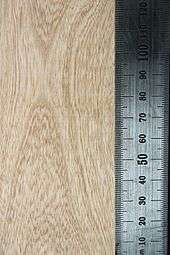
The wood is pale grey to whitish, straight-grained, relatively soft and knot-free. It dries without difficulty and is often used in its green or wet state for turnery and bowl carving.
Taxonomy
The taxonomic status of the blue jacaranda is unsettled. ITIS regards the older name, J. acutifolia, as a synonym for J. mimosifolia. However, some modern taxonomists maintain the distinction between these two species, regarding them as geographically distinct: J. acutifolia is endemic to Peru, while J. mimosifolia is native to Bolivia and Argentina. If this distinction is made, cultivated forms should be treated as J. mimosifolia, since they are believed to derive from Argentine stock. Other synonyms for the blue jacaranda are J. chelonia and J. ovalifolia. The blue jacaranda belongs to the section Monolobos of the genus Jacaranda.
Places known for their jacarandas
The city of Grafton on the north coast of New South Wales, Australia, is famous for its jacarandas. Each year in late October and early November, the city has a jacaranda festival.[6]
In the United States, the jacaranda is grown extensively in California, the Southwest, southeast Texas and Florida.[7] Jacaranda can be found throughout most of Southern California, where they were imported by the horticulturalist Kate Sessions.[8] They are also planted as far north as the San Francisco Bay Area and along the frost-free coastal regions of Northern California.[7][9] Phoenix, Arizona and San Diego, California are known for them.
In Europe the jacaranda is grown on the Mediterranean coast of Spain (it is prominent in the Valencian Community, the Balearic Islands and Andalusia, with especially large specimens present in Valencia, Alicante and Seville, and usually with earlier flowering than in the rest of Europe), in southern Portugal (notably in Lisbon), southern Italy (Naples and Cagliari have many mature specimens), southern Greece (especially Athens) and the islands of Malta and Cyprus. It was introduced to Cape Town by Baron von Ludwig about 1829. In Africa jacarandas are especially present in Lusaka, the capital of Zambia; Nairobi, the capital of Kenya; and Harare, the capital of Zimbabwe.
Popular culture references
Pretoria, the administrative capital of South Africa, is popularly and poetically known as Jacaranda City or Jakarandastad in Afrikaans because of the large number of trees, which turn the city blue when they flower in spring. The name Jakarandastad is frequently used in Afrikaans songs, such as in Staan Op by Kurt Darren. The jacaranda trees, far from their native Brazil, bloom every October. Water scarcity has South Africa trying to eradicate foreign species of plants and trees, including the jacaranda. Acknowledging the tree's popularity with locals, the government has announced that it will not remove the trees, but has banned the planting of new jacarandas.[10]
The Australian Christmas song "Christmas Where The Gum Trees Grow" makes reference to jacaranda trees, as the blooms are only seen in summer time—as the song explains, "When the bloom of the jacaranda tree is here, Christmas time is near".[11] The University of Queensland in Brisbane is particularly well known for its ornamental jacarandas, and a common maxim among students holds that the blooming of the jacarandas signals the time for serious study for end-of-year exams.[12]
In Argentina, writer Alejandro Dolina, in his book Crónicas del Ángel Gris (Chronicles of the Gray Angel), tells the legend of a massive jacarandá tree, planted in Plaza Flores in Buenos Aires, that was able to whistle tango songs on demand. María Elena Walsh dedicated her song Canción del Jacarandá to the tree. Miguel Brascó's folk song Santafesino de veras mentions the aroma of jacarandá as a defining feature of the littoral Santa Fe Province (along with the willows growing by the rivers).
Folklore
Purple panic is a term used by students in south-east Queensland for student stress during the period of late spring and early summer. The "purple" refers to the flowers of Jacaranda trees, which bloom at that time and have been extensively planted throughout that district. The "panic" refers to the need to be completing assignments and studying for final exams.[15]
The Jacaranda when in bloom is also known as the exam tree.[15]
Conversely, while the time of year the jacarandas bloom in Pretoria coincides with the year-end exams at the University of Pretoria, legend has it there that if a flower from a jacaranda drops on a student's head, the student will pass all their exams.[16][17]
References
- "Jacaranda mimosifolia". Germplasm Resources Information Network (GRIN). Agricultural Research Service (ARS), United States Department of Agriculture (USDA). Retrieved 2008-03-09.
- The Plant List: A Working List of All Plant Species, retrieved 10 September 2016
- Prado, D. (1998-01-01). "IUCN Red List of Threatened Species: Jacaranda mimosifolia". IUCN Red List of Threatened Species. doi:10.2305/iucn.uk.1998.rlts.t32027a9675619.en. Retrieved 2020-06-16.
- Kathleen Norris Brenzel (2007). Sunset Western Garden Book. Sunset Publishing Group. p. 415.
- Agroforestry Database 4.0 (Orwa et al. 2009)
- "Jacaranda Festival Grafton".
- Edward F. Gilman and Dennis G. Watson2 (November 1993). "Jacaranda Mimosifolia Fact Sheet" (PDF). hort.ifas.ufl.edu. Retrieved 2019-02-21.
- Howser, Huell. "#15006 Jacaranda". California's Gold. Archived from the original on 2013-01-12.
- Buzz Bertolero (2006-10-06). "Jacaranda trees growing in popularity in Bay Area". East Bay Times. Retrieved 2019-02-21.
- lyricsplayground.com
- UQ Centenary 2010 - Jacaranda and Sandstone
- "Australians mourn tree that 'failed' university students". BBC News. 2016-10-31. Retrieved 2016-10-31.
- "University community mourns jacaranda tree collapse". The University of Sydney. Retrieved 2016-11-06.
- "Jacarandas signal 'purple panic'". The Chronicle. Retrieved 29 February 2016.
- "It's Purple Paradise as Jacarandas Bloom & Exams start soon!". SA people NEWS. 2014-10-27. Retrieved 29 February 2016.
- "The Jacaranda City". ShowMe South Africa. Retrieved 29 February 2016.
External links
| Wikimedia Commons has media related to Jacaranda mimosifolia. |
- Prado (1998). "Jacaranda mimosifolia". IUCN Red List of Threatened Species. 1998. Retrieved 11 May 2006.CS1 maint: ref=harv (link) Listed as Vulnerable (VU B1+2ac v2.3)
- Dressler, S.; Schmidt, M. & Zizka, G. (2014). "Jacaranda mimosifolia". African plants – a Photo Guide. Frankfurt/Main: Forschungsinstitut Senckenberg.

